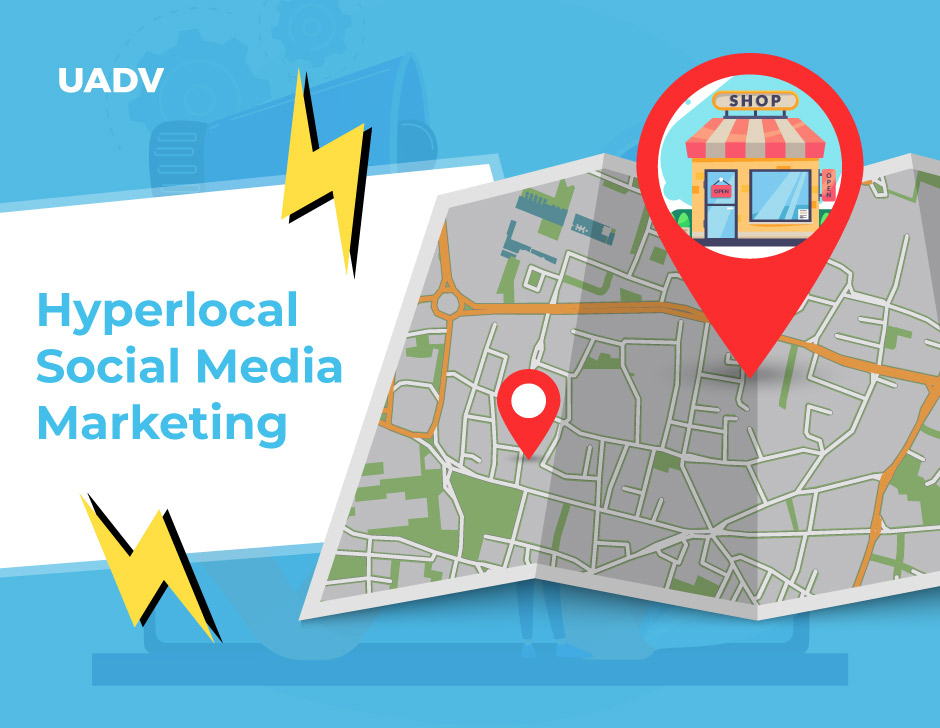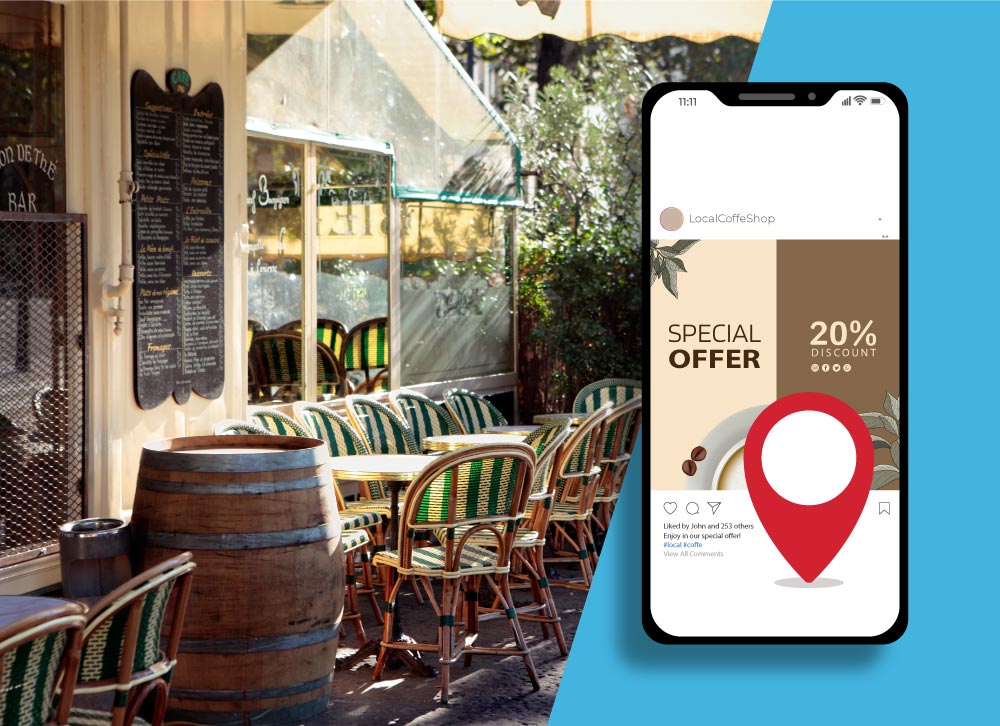
Hyperlocal Social Media Marketing: Complete Strategy Guide
‘Near Me’ searches have increased by 500% in the past two years. This tells us one thing: consumers are increasingly prioritizing proximity even when making online purchases. As forward-thinking business owners, it becomes imperative to implement a strategy that allows us to leverage this trend effectively. This is where hyperlocal social media marketing comes into play.
Hyperlocal social media marketing targets specific geographic areas with precision, connecting businesses directly with potential customers in their immediate vicinity. In this comprehensive strategy guide, we'll explain hyperlocal social media marketing and guide you through implementing this marketing strategy in your business.
What Is Hyperlocal Social Media Marketing?
Hyperlocal social media marketing is a specialized digital marketing strategy that focuses on promoting products or services to a highly localized audience, typically within a specific neighborhood, town, or even a single street. Unlike broader digital marketing efforts that cast a wide net to reach a general audience, hyperlocal marketing narrows its scope to engage with individuals who are physically close to a business's location.
Hyperlocal marketing emphasizes engagement with the local community. It's not just about selling products or services; it's about becoming an integral part of the neighborhood's online conversation and culture.
This strategy harnesses the power of social media platforms to connect with potential customers based on their geographical proximity, making it an incredibly effective approach for businesses aiming to increase their local presence.

What Is An Example Of Hyperlocal Social Marketing?
Let's consider a small, family-owned medical practice, "Greenwood Family Health," located in a residential area. To effectively employ hyperlocal social media marketing, Greenwood Family Health would utilize social media advertising tools to create geo-targeted campaigns. This strategy ensures that their informational posts, health tips, and service promotions are only visible to users within a specific radius of the practice.
By doing this, they're reaching potential patients who are in the vicinity and are more likely to seek medical services nearby. Additionally, they can share updates about community health events or seasonal health tips, further establishing themselves as a valuable and accessible healthcare resource for the local community.

Hyperlocal Digital Marketing vs. Traditional Marketing
While both approaches have their strengths, digital marketing, especially hyperlocal strategies, offers distinct advantages in modern business. Here are some of these advantages:
Real-Time Responsiveness
One of the most significant advantages of hyperlocal digital marketing is its real-time responsiveness. Digital campaigns can be adjusted and optimized on the go, enabling businesses to react swiftly to changing market conditions or customer feedback. For instance, imagine you own a small coffee shop. With traditional marketing, a printed flier or newspaper ad could take days or weeks to create and distribute. If you wanted to promote a limited-time offer, you might miss the opportunity entirely.
In contrast, hyperlocal digital marketing allows you to create a targeted social media post announcing the special offer, and you can even boost it to reach a specific radius around your cafe. This instant communication with your local audience can significantly impact foot traffic and sales.
Cost-Effectiveness
Traditional marketing methods often come with substantial costs, especially for print and broadcast advertising. Producing and distributing flyers, running newspaper ads, or airing TV and radio commercials can quickly drain a small business's marketing budget. Alternatively, hyperlocal digital marketing offers a cost-effective alternative.
Social media platforms allow you to set precise budgets for your campaigns, ensuring that you're only spending money to reach your local target audience. This level of budget control is a game-changer for small businesses with limited resources.
Precise Audience Targeting
Traditional marketing relies on broad strokes to reach a general audience, often resulting in wasted resources and a lower return on investment (ROI). Hyperlocal digital marketing, on the other hand, provides the ability to target your message with pinpoint accuracy. You can define your audience based on location, demographics, interests, and even behaviors.
Let’s say you operate a boutique fitness studio. You can use hyperlocal digital marketing to exclusively target individuals within a 10-mile radius who have expressed an interest in fitness or related activities on social media. This level of precision ensures that your marketing efforts are directed toward the people most likely to become customers, maximizing your ROI.

What Are The Benefits Of Hyperlocal Marketing?
Let’s take a look at some of the astonishing benefits of hyperlocal social media marketing:
1. Increased Relevance And Personalization
Hyperlocal social marketing enables businesses to deliver highly relevant and personalized content. Tailoring messages to local audiences fosters a deeper connection with potential customers, exemplifying the effectiveness of personalization in driving engagement.
2. Enhanced Customer Engagement
Hyperlocal marketing actively fosters engagement within local communities as it propels you to explore strategies for igniting conversations and interactions on social media, leading to increased customer loyalty and brand advocacy.
Both customer loyalty and brand advocacy are crucial for the success of any business, especially in a hyperlocal context. By engaging directly with the local community, businesses create a sense of belonging and connection. This not only nurtures customer loyalty but also turns satisfied customers into brand advocates. These advocates, often local residents themselves, become invaluable assets, spreading positive word-of-mouth and enhancing the brand's reputation within the community.
3. Cost-Effective Advertising
Hyperlocal marketing offers significant cost benefits compared to broader advertising campaigns by focusing resources on targeted geographic areas. This precision in targeting ensures that advertising budgets are spent effectively, reaching potential customers in close proximity to the business. This approach not only improves return on investment but also minimizes wasted impressions, leading to a higher likelihood of conversion.
Leveraging social media platforms for hyperlocal campaigns further enhances cost-efficiency. Platforms like Facebook and Instagram provide advanced geo-targeting tools, allowing businesses to display ads to a highly relevant audience based on their location. Additionally, these platforms offer flexible budgeting options, making them ideal for businesses with limited marketing funds. By engaging in local community activities and collaborations on social media, businesses can amplify their reach organically, adding to the cost-effectiveness of their marketing efforts.
4. In-Depth Data Insights
Targeting a hyperlocal audience generates valuable data and profound insights. By analyzing the behavior, preferences, and demographics of local customers, businesses can refine their marketing strategies and make well-informed decisions. This detailed understanding of the local market can lead to more effective campaigns and an enhanced return on investment (ROI).
Hyperlocal Marketing Strategy
To harness the full potential of your hyperlocal marketing strategy, follow this comprehensive, six-step outline. Each step is designed to guide you seamlessly through the process, ensuring that your approach is not only effective but also resonates deeply with your local community.

1. Identifying Your Hyperlocal Audience
This involves a detailed analysis of the local market. Start by pinpointing the geographic area you intend to serve, whether it's a neighborhood, a city, or a specific region. Utilize data and analytics to segment the audience based on their location, interests, and consumer behavior. This segmentation can be accomplished through tools like Google Analytics or local market research.
Understanding local preferences and behaviors is crucial. This can involve studying local trends, cultural nuances, and consumer habits specific to the area. Surveys, focus groups, and community feedback can provide valuable insights into what the local audience values and expects. Tailoring your marketing efforts to resonate with these local preferences can significantly increase engagement and customer loyalty.
2. Leveraging Social Media Platforms
Social media platforms are vital in hyperlocal marketing due to their ability to target specific geographic areas. Platforms like Facebook, Instagram, and Twitter offer tools to target ads and content to audiences in specific locations. For example, Instagram's location tags and Facebook's local groups can be used effectively to reach a hyperlocal audience.
Best practices for these platforms include engaging with local influencers, participating in community discussions, and creating content that reflects local interests. Highlighting local events, featuring customer stories from the area, and using local dialects or slang can also enhance the local appeal. Successful hyperlocal social media campaigns often include a mix of paid advertisements targeted to specific zip codes and organic content that resonates with the local community.
3. Content Creation and Localization
Effective hyperlocal marketing requires content that speaks directly to the local audience. This involves creating well-structured categories and tag pages on your website, each with descriptive titles and meta descriptions incorporating local keywords. This SEO-friendly approach helps it appear in local search results.
Content should be localized, meaning it should reflect local culture, news, and events. It’s not just about translating content into a local language but also about adapting it to local contexts. For instance, a blog post about holiday shopping trends should reference local festivals or customs. Internal linking between related local content can enhance user engagement and improve SEO.
4. Building Local Partnerships
Partnering with local businesses and organizations is a cornerstone of hyperlocal marketing. These partnerships can range from cross-promotional activities, like shared marketing campaigns or co-hosted events, to community involvement projects that enhance your brand's local presence and reputation.
Engaging in local events or collaborating with local charities are excellent ways to build a network and gain visibility in the community. This approach not only broadens your reach but also establishes your business as an integral part of the local ecosystem, fostering trust and loyalty among the local population.
5. Tracking and Measuring Success
To measure the success of this strategy, start by defining key performance indicators (KPIs) specific to your hyperlocal marketing efforts. These might include local website traffic, engagement rates, lead generation, or foot traffic for brick-and-mortar businesses.
If you mostly use social media for your hyperlocal marketing, then you should use social media analytics tools to track the performance of your hyperlocal campaigns. Monitor metrics like reach, engagement, click-through rates, and conversion rates. After analysis, find out which tactics are not delivering results, and be ready to pivot and try new approaches.

6. Hyperlocal SEO Integration
Local SEO is crucial for making your business visible in local searches, essentially acting as a digital beacon in your community. Key strategies include incorporating location-specific keywords into your website content and ensuring mobile optimization, as most local searches are on mobile devices. Building local backlinks and creating content centered around local events and culture further cements your relevance in the community.
Another thing to note is that Google My Business (GMB) is vital for managing your online presence across Google platforms. Keeping your GMB profile updated with accurate business information, responding to online reviews, and using these reviews in your marketing efforts are effective ways to enhance engagement and local SEO. This approach not only boosts your search ranking but also strengthens your connection with the local audience.
Choose The Right Social Media Channels
When it comes to hyperlocal marketing, not all social media platforms offer the same level of geo-targeting capabilities. Here's what you need to know about the geotargeting features of various popular social media platforms:
Facebook and Instagram
Facebook and Instagram are powerhouse platforms for hyperlocal marketing. They offer robust geo-targeting options, allowing you to narrow your audience down to specific neighborhoods or even individual locations. With their extensive user base, these platforms provide ample opportunities to connect with local customers, such as through sponsored posts and stories that can be tailored to the interests and behaviors of a hyperlocal audience.
X (Twitter)
Unfortunately, Twitter's geotargeting capabilities are more limited compared to Facebook and Instagram. While you can target by location, it may not provide the same granularity as other platforms. However, it can still be effective for broader local targeting.
LinkedIn is valuable for hyperlocal marketing in a B2B context. You can target local professionals and businesses based on their industry, job titles, and company size. While it may not offer hyperlocal targeting like Facebook, it's excellent for reaching local business networks.
TikTok
TikTok's geo-targeting capabilities are improving, making it a viable option for hyperlocal marketing. You can target users based on their location, but keep in mind that TikTok's user base skews younger, so it's best suited for businesses targeting a younger local audience.
YouTube
YouTube, owned by Google, provides geo-targeting options through Google Ads. You can target users based on their location, interests, and viewing behavior. YouTube's reach and visual format can be beneficial for hyperlocal video marketing.
Target Your Audience Carefully
Geo-ads are renowned for their high accuracy in reaching the right audience. To maximize the effectiveness of your hyperlocal marketing efforts, consider these common options for modifying your social media advertising campaigns:
- Interests
Tailor your ads to users' interests relevant to your local audience. Whether it's hobbies, lifestyle choices, or preferences, aligning with local interests can boost engagement.
- Demographics
Customize your targeting based on demographic factors such as age, gender, income, and education. Understanding the local demographics helps you create content that resonates.
- Custom Audiences
Build custom audiences using your existing customer data or website visitors. This enables you to re-engage with previous customers or target users who have shown interest in your products or services.
- Behavior
Leverage behavioral data to refine your targeting. Consider user behavior like online shopping habits, engagement with local content, or specific actions taken on your website.
- Lookalike / similar audiences
Expand your reach by creating lookalikes or similar audiences. Social media platforms can identify users with profiles resembling those of your existing customers, helping you tap into new local markets.
Conclusion
Hyperlocal marketing is the future, especially on social media. It's all about getting closer to your local community, understanding what they like, and using that knowledge to offer them exactly what they need. This way of marketing lets businesses talk directly to local customers, making them feel special and understood. It's great because it focuses your efforts on a specific area, which means you can really connect with people and build a loyal group of customers who love your brand.
For any business, big or small, using hyperlocal strategies is a smart move. It helps you stand out and create a strong bond with your community. You can do this easily through social media by talking about things that matter to your local customers and showing that you're part of their world.
So, why not start your own hyperlocal campaign on social media? Get to know your local customers, talk about things they care about, and show them how your business fits into their lives. It's about being a friendly face in the neighborhood, not just another business. Give it a try, and you'll see how being local can really help your business grow.
Why continue wasting more time and money on marketing strategies that don't work? Your business deserves better marketing. Say goodbye to empty promises and half-ass results; UADV is the only full-service marketing agency that grows your business (no excuses). Get a free consultation with our expert team now, or check out some of our success stories!

Frequently Asked Questions
What Social Media Platforms Are Most Effective For Hyperlocal Social Marketing Efforts?
For hyperlocal marketing, platforms like Facebook, Instagram, and Twitter are incredibly effective. Facebook and Instagram excel due to their advanced targeting features, allowing businesses to reach audiences in specific geographic locations. Localized hashtags and geotags on Instagram are particularly useful for catching the attention of a local audience.
Are There Any Specific Strategies For Targeting A Hyperlocal Audience On Social Media?
Targeting a hyperlocal audience on social media involves strategies like using location-based targeting in ads, which allows businesses to display content to users in specific areas. Creating content that resonates with local interests, such as featuring local events or community news, also helps build a connection with the audience.
How Do I Identify And Connect With My Hyperlocal Audience On Social Platforms?
To identify a hyperlocal audience on social platforms, start by researching the demographics and interests of the community you're targeting. Engage in local groups and forums on platforms like Nextdoor to understand the local discourse. You can also use social listening tools to monitor conversations about your area.
Are There Any Privacy Concerns Associated With Hyperlocal Marketing?
Hyperlocal marketing does raise some privacy concerns, primarily related to the use of personal data for targeted advertising. The key concern is how location data and other personal information are collected, used, and stored. Businesses must ensure compliance with data protection laws, which regulate the use of personal data.

.webp)


